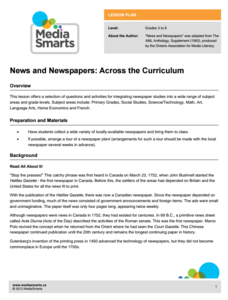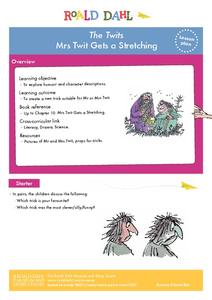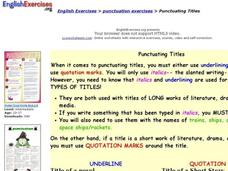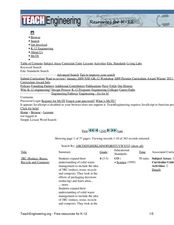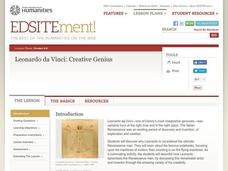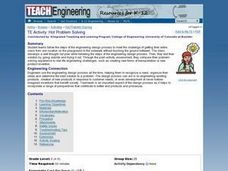Curated OER
Mathematics in Bioengineering: Its Application for Today's Students
High schoolers explore the different fields of bioengineering. They will create and interpret graphs from cancel cells data. They then calculate the amount of drugs found in blood and eliminated by the body over time.
Media Smarts
News and Newspapers: Across the Curriculum
Did you know that the Chinese Court Gazette is the longest continuing news paper in history? In addition to some great background information, this resource includes suggestions for activities across grade levels and across the curriculum.
NASA
Applying Newton’s Laws
Newton's Laws get the rocket to work, but do they serve any other functions? A six-page resource classifies rockets by the type of propellant they use. It then describes applications of Newton's Laws of Motion, both in the ability to...
Teach Engineering
Let's Take a Spin: One-Axis Rotation
Investigate the effect of one-axis rotations on geometric figures. Scholars learn to use snap cubes and the right-hand rule to draw figures after rotations about the x-, y-, or z-axes. They try their hands at examples created by the...
Teach Engineering
Exploring Energy: Energy Conversion
The energy is not really lost, it is just converted to a different form. Pupils learn about the conversion of energy in the fifth segment of an energy unit with six parts. Learners develop an understanding of the conservation of energy...
Roald Dahl
The Twits - Mrs Twit Gets a Stretching
A cork, a rubber snake, and a bucket of mud may not seem like the best materials for washing a car, but they are in The Twits. The fifth lesson in an 11-part unit designed to accompany The Twits by Roald Dahl has readers role play...
Curated OER
ESL: Punctuating Titles
When are titles underlined, italicized, or placed in quotation marks? Take your class to the computer lab to give them some independent practice. Here they read through the information, examples, and explanations provided. They then...
Curated OER
Revolutionary Money
Examine paper money from the American revolution! Historians study the paper bills and discuss the history of money. How has money changed over the times? Activities are included.
Curated OER
Shapes
Learners participate in a number of hands-on shape-related activities. They match and sort shapes by attribute, read books about shapes, complete shape art projects and explore and compare parts of shapes.
Teach Engineering
The Advantage of Machines
Show your students how to make their work easier. The first lesson in a series of 10 introduces the class to work and the way simple machines can be make work easier. The simple machines scholars can find in everyday items are inclined...
Curated OER
Firebird
Elementary schoolers read the Firebird reading list of fantasy and complete discussion questions about fantasy. In this fantasy books lesson plan, students read a list of books and pick one to read.
Teach Engineering
See the Genes
"If you can't explain it simply, you don't understand it well enough" - Albert Einstein. The sixth installment of a seven-part series teaches young scientists about the importance of being able to communicate scientific research and...
Curated OER
Cross Country Adventure
Students practice measurement and geography in this lesson. They build a Lego vehicle using an RCX. They predict how many seconds it will take their vehicle to reach a specific state on the United States of America map that each group of...
Curated OER
Problem Solution Writing
Students, after brainstorming possible problem solving activities, choose from one of the many and write what the problem is and a solution to solve it.
Curated OER
The National Math Trail
Students explore the many applications of mathematics in their environment . They formulate and solve mathematics problems. Students describe geometric elements, shapes and relationships. Students use technology such as digital cameras...
Curated OER
Personalities of the Renaissance
Have the class interpret historical evidence presented in primary and secondary resources. They examine sources regarding architecture, art, exploration, government, literature, religion, and technology of the era. Then they use their...
Curated OER
Technology, R&D, and Efficiency
For use in conjunction with the 2002 McGraw-Hill/Irwin US Economics text, this presentation highlights key points and important vocabulary. Specific economic concepts and theories, R & D expenditures, rate-of-return curve and...
Curated OER
Poppin Popcorn
Students use their senses to write descriptive sentences. In this descriptive writing lesson, students discuss their senses. Students are asked to look at and feel unpopped corn kernels. Students then write descriptions of the corn...
Curated OER
Classical Greece
Students research historical events in ancient Greece. In this ancient Greece lesson, students design a magazine which includes a cover, table of contents, cover story, advertisement and visuals. Students focus on Pericles and his...
Curated OER
Time for Design
Learners are introduced to the design process used in engineering. They compare and contrast this process with the steps followed in the scientific method. Students then participate in a brainstorming session that asks them to design a...
Curated OER
Leonardo da Vinci: Creative Genius
Young scholars examine how Leonardo da Vinci exemplified the Renaissance period. They explore various websites, conduct Internet research, complete a chart, explore virtual da Vinci notebooks, and write an essay.
Curated OER
How Do Car Engines Work?
Students perform an experiment which simulates what happens inside an internal combustion engine. They explain how the chemical reaction they witnessed is similar to what happens inside the car engine.
Curated OER
Hot Problem Solving
Students follow the steps of the engineering design process to meet the challenge of getting their entire class from one location on the playground to the sidewalk without touching the ground between. The class develops a well...
Curated OER
Understanding Mayan Culture
Students study an ancient culture in Mexico whose people were called the Mayans. They compare certain aspects of Mayan culture with Ancient Egypt. They discuss why some other ancient cultures (Egypt and China) were able to survive for...
Other popular searches
- Science Inventions 6th Grade
- Science Inventions 1st Grade
- Ancient Science Inventions
- Science Inventions 6th
- Incidence Science Inventions
- Physical Science Inventions
- Science Inventions Eliticity
- Ancience Science Inventions
- Science Inventions Eletisty
- Science Inventions Elitist
- Science Inventions Elasticity



